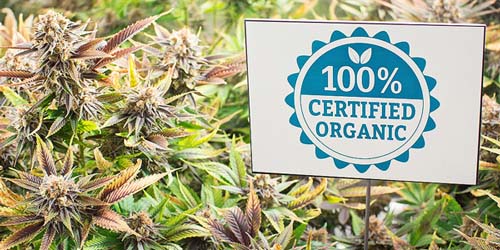
One of the benefits of growing organic weed is that it is better for your health and the environment of your weed plant. To grow organic weed, you need to consider some differences from non-organic. The plant food you choose is perhaps the most important. In this article, we will walk you through those differences step by step.
What is organic weed? What do you need to watch out for?
Before you start growing organic weed it's helpful to know exactly what organic weed is.
Bio Label
Where other products for consumption have to meet strict requirements to be labeled "organic", weed does not (yet) have to meet these requirements in the Netherlands. The catch is that upon full legalization, this type of label will also be placed on marijuana and other cannabis products. So organic weed is not a protected term and therefore you have to believe the coffee shop, for example, that it is indeed organically grown. But what exactly does that mean?
Meaning of Organic
That something has been grown organically means that it has been grown without harming the environment. In practice, this means that you can only use plant nutrition, stimulants and pesticides that carry a seal of approval that they are suitable for organic cultivation. So those products themselves do not have to be organic, but they can be. With pesticides, you should also think about solving an infestation naturally. For example, if you suffer from aphids, introduce the natural enemy on the weed plant; ladybugs.
The advantage for the end consumer is that you can be sure there is no weird junk in your food that could be harmful to you. With food and supplements, this is checked by an external agency that is then allowed to put a label on the package that the product meets the standards for organic. But this is not (yet) the case with marijuana.
When to grow organically?
Growing organic weed is a good idea especially in the garden. Because you leave surrounding plants, bugs and fungi in the soil alone as much as possible, a harmony is created between all life in the environment of your weed plant. This creates a living environment that is not only good for this weed plant, but also for the plants you put in your garden afterwards. The idea is that the soil is not depleted and the environment remains intact. Next, especially for medicinal users and conscious smokers, it is extra valuable to know exactly what your weed was grown with. That way, you know what you're putting into your body and what you're leaving out.
Step 1: Indoor or Outdoor Weed Growing?
Whatever type of weed you're going to grow, it's important to decide beforehand where you want the plant to grow. Will you choose the garden, greenhouse or an indoor grow room? Growing weed in the garden may be the most natural, but the elements can also provide challenges during cultivation. Think mold, rot or pests that you then have to deal with organically. If that's too challenging, or if you're afraid the neighbors won't like the sight or smell of weed, consider the MiniGrow Box. That's an air- and light-tight luxury grow box that includes all the latest technology to help your weed plant grow big and strong. Growing organic weed in this kind of grow box is a lot easier.
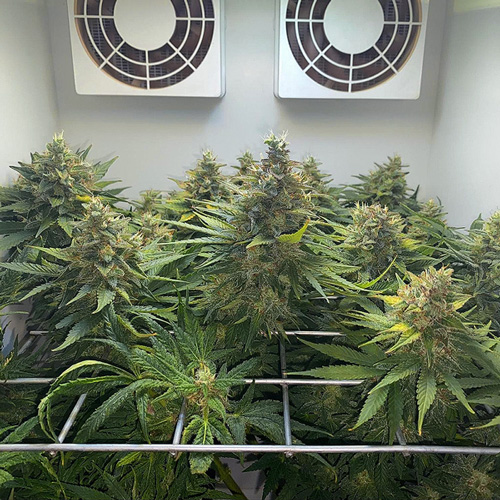
Step 2: Selecting your weed seeds
Basically, any weed seed is suitable for growing organic weed, but we recommend choosing seeds from which naturally strong plants come out that are more resistant to mold, for example. This ensures that you will run into fewer problems later on and won't need pesticides at all. And the less you need: the better for the environment, your health and your wallet! Choose, for example:
Master Kush |
Durban Dew (Dutch Passion) |
Auto LSD |
Auto Blue Dream |
|
Indica photoperiod (great for outdoors). |
Sativa photoperiod (great for outdoors). |
Indica autoflower (great for indoor use). |
Sativa autoflower (great for indoor use). |
|
Perfect balance between physical relaxation and motivation to do something. |
Long lasting euphoric high. |
Psychedelic body high. |
A euphoric high and relaxed feeling. |
|
Outdoor yield: 700 grams per plant under ideal conditions. |
Outdoor yield: 1000 grams per plant under ideal conditions. |
Nice yield of about 100 grams per plant. |
200 grams per plant. |
|
THC: 15 to 18%. |
THC percentage around 21% (under ideal conditions). |
THC: 16% - 20%. |
THC: 13%. |
|
Month of harvest outdoors: Late September. |
Month of harvest outdoors: Early October. |
Flowering period indoors: approximately 8 weeks. |
Flowering period indoors: 9 weeks. |
Step 3: Stocking up on Nutrition and Possibly Stimulators
Weed plants need plant nutrition. And some nutrients are particularly suitable for organic growing. That's because they carry a certain seal of approval or even a certificate for organic growing. Those kinds of certificates are handed out by The Soil Association, SKAL, envirOrganic, and EcoCert, among others.
For the growing stage of your weed plant, for example, choose:
During the flowering phase, the needs of the weed plant change. For organic weed growing then use, for example
Not required, but definitely recommended are stimulators. You can think of these as nutritional supplements with which your organic weed plants get fatter roots or flower more profusely. These additives are absolutely top notch for this purpose:
With Power Roots, Piranha or Organic root stimulator you stimulate the soil life which makes the roots grow better. Organic PK Booster and Sugar Royal are suitable for stimulating flowering and improving the taste of your weed organically.
Step 4: Buy potting soil or garden soil and enrich if necessary
If you are growing in potting soil (to use in a pot) or garden soil (to use outdoors), we recommend enriching your soil with some organic love beforehand. Voodoo Juice, Mega Worm, Funky Fungi and Bat Guano provide nutrition to the microbiological life in the soil. In fact, bacteria and fungi interact with your weed plant, providing each other with needed nutrients. In addition, they accelerate transport and optimize juice flow in the roots, making nutrition, oxygen and water all more absorbable.
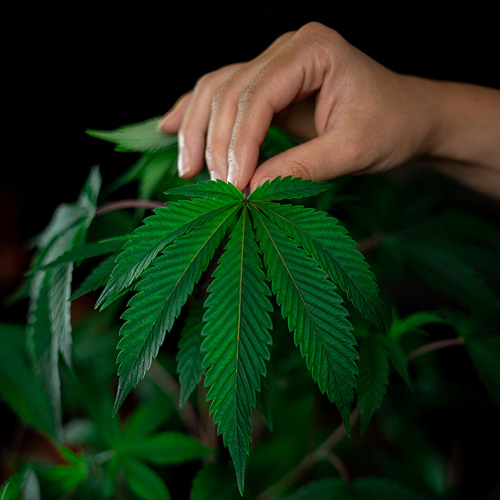
Step 5: Germinate
Then it's time to germinate your weed seeds. This is as exciting as it gets with non-organic weed, as long as you don't use any chemical stuff during germination. In any case, make sure you germinate separately. After all, weed seeds do not tolerate the rich soil very well. Therefore, do not introduce the young weed plants to the soil until they are strong enough. So germinate them separately and preferably let them pre-grow.
For detailed help with germination, we would like to refer you to the following blogs:
- Big Research: Germinating Weed Seeds - Glass of Water, Coffee Filter, and More
- Help! My Weed Seeds Are Not Germinating
- Germinating Cannabis Seeds with a Spongepot
- Germinating cannabis seeds with wads and Dutch-Headshop tray
Step 6: Taking care of your weed plant
During the growth and flowering of your weed plant, you should follow the advice of the manufacturer of your nutrition as closely as possible. Plagron has a slightly different approach than Advanced Nutrients or BAC. Here are all the growing schedules:
Watering your weed plant
Watering a weed plant is not rocket science, but you must take drainage into account. Holes in the pot and/or airy soil allow excess water to drain away and air to flow through the soil. This prevents your weed plant from getting wet feet and therefore roots could rot. Weed nutrition is given at the same time as watering. If you do, you can also measure the pH to make sure the acidity in the soil stays at the ideal level. You can read how to do this in the blog about measuring pH. Keeping the pH level up prevents your weed plant from suddenly not being able to absorb certain nutrients that can lead to leaf problems. When growing weed, the pH is often higher than you would like. Therefore, you rarely need to adjust the pH upwards. When growing organic weed, it is best to use Lemon Kick to lower the pH.
Oh dear, leaf problems on my weed plant
Lice, mites or spider mites on your weed plant? No problem. If you encounter bugs, nine times out of ten you can remove them without spraying all kinds of harmful substances on your delicate weed plant. Consider, for example, 100% vegetable neem oil. This will get rid of mealworms, aphids, spider mites, sciarid flies, thrips, white flies, fungus gnats, leaf-eating beetles and even fungi such as mildew and downy mildew. Neem oil is therefore widely applicable. No effect with repeated treatments? Then try Total Explosion or Spidermite control for a more direct approach.
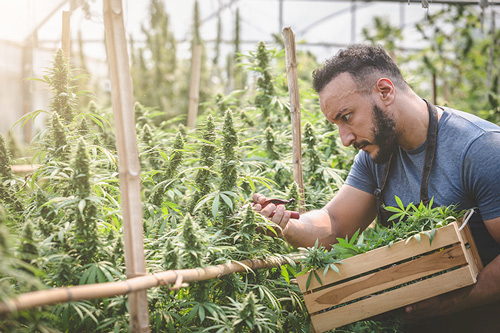
Crazy colors in organic weed
If your weed plant changes color, it is often a sign that there is something wrong with the nutrition or water management. This happens when watering incorrectly or deviating from the growing schedule. For example, a heavy yellow leaf means that the plant is being watered too often. But if the leaf is yellow and not hanging limply, it indicates a nitrogen deficiency. Unfortunately, anything can go wrong with your plant, but the strongest plants often recover. However, it is advisable to listen to your plant, but you have to speak your weed plant's language. Start with the blog “recognizing deficiencies in weed plants”.
Step 7: Organic Weed Harvesting
Before you harvest weed, it's a good idea to flush your weed. By not adding any more nutrition to the waterings in the last 1 to 2 weeks before harvest, you flush all the remaining nutrition out of the soil. This makes the weed taste better.
Fortunately, there are no extra points of attention for organic weed during harvest. We do recommend that you dry and cure your weed thoroughly after the harvest. If you could use some help with that, read the following blog.
> Curing and Drying Cannabis in a Few Simple Steps
Summary Organic Weed Growing
Some strains are more resistant to external influences than others. The less you have to do or add during an organic grow, the better. That said, some additives are actually advisable. For example, because they provide a higher yield. Whether you choose to do so or not, plant nutrition is necessary. In that case, choose plant nutrition that is suitable for organic weed growing. And are you bothered by bugs on the weed plant? Try a natural pesticide such as neem oil first. This is safer for your weed plant, but also for you when you are enjoying your organic weed after harvesting.
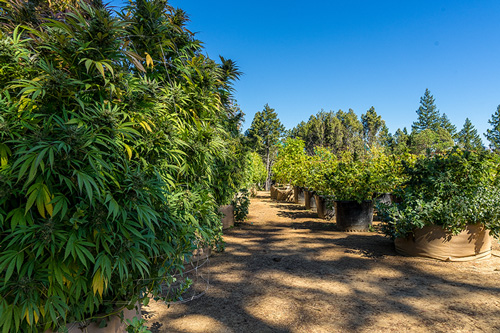
All plant nutrition and tools that are suitable for growing organic weed can be found in the category for weed seeds. Use the filter "suitable for organic growing" to get an overview of all the products you can safely use for your plant, the soil and surrounding life.